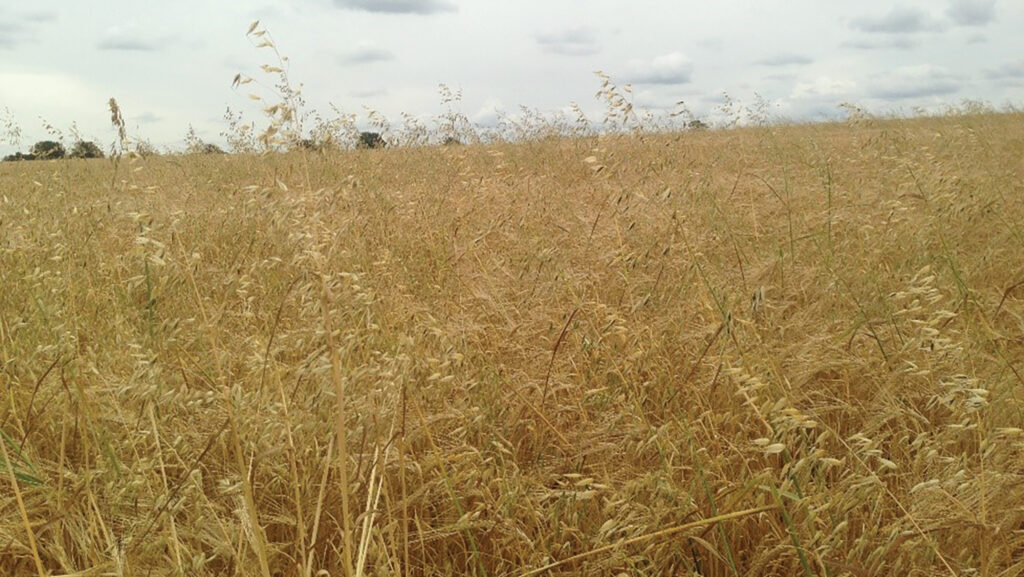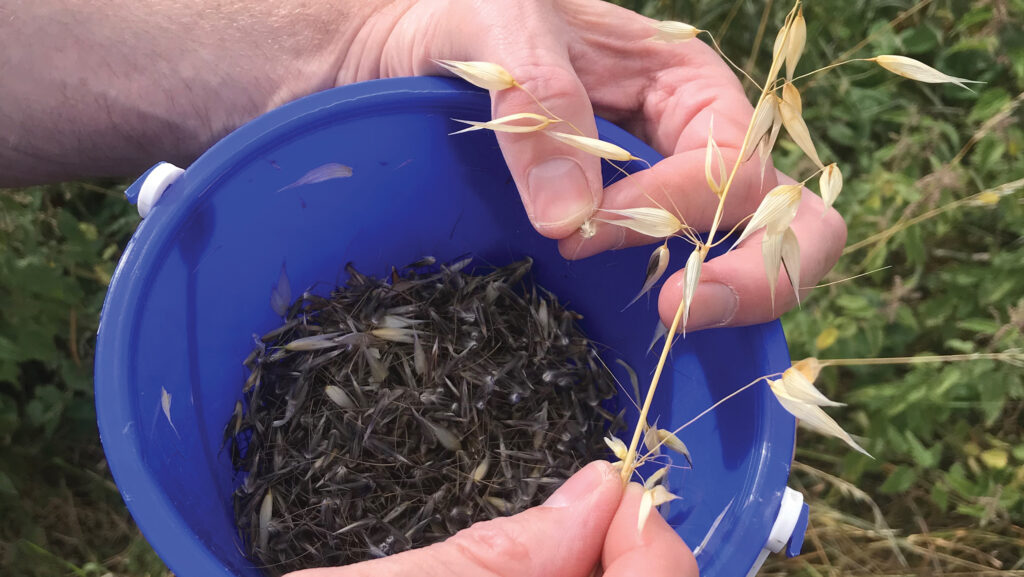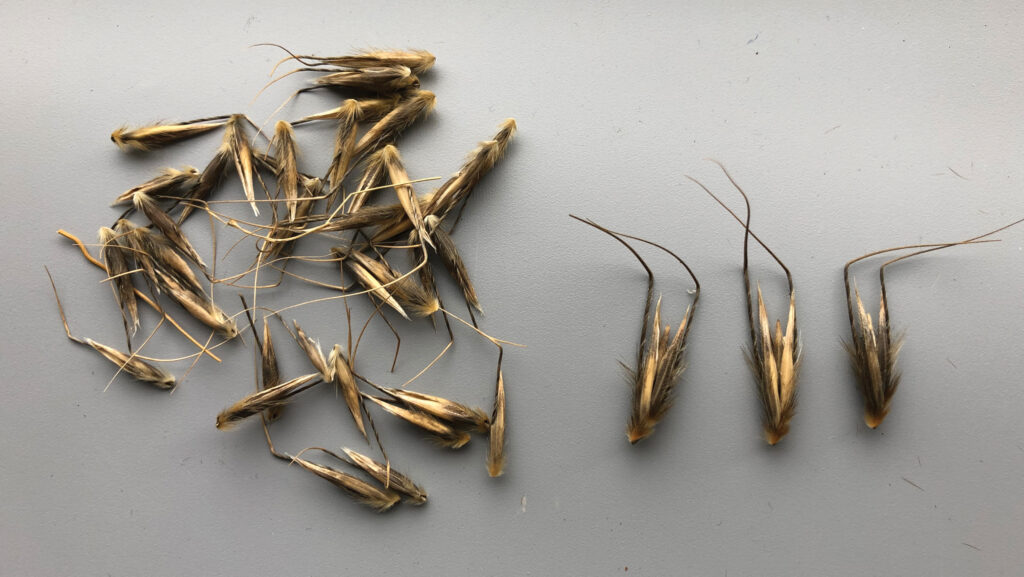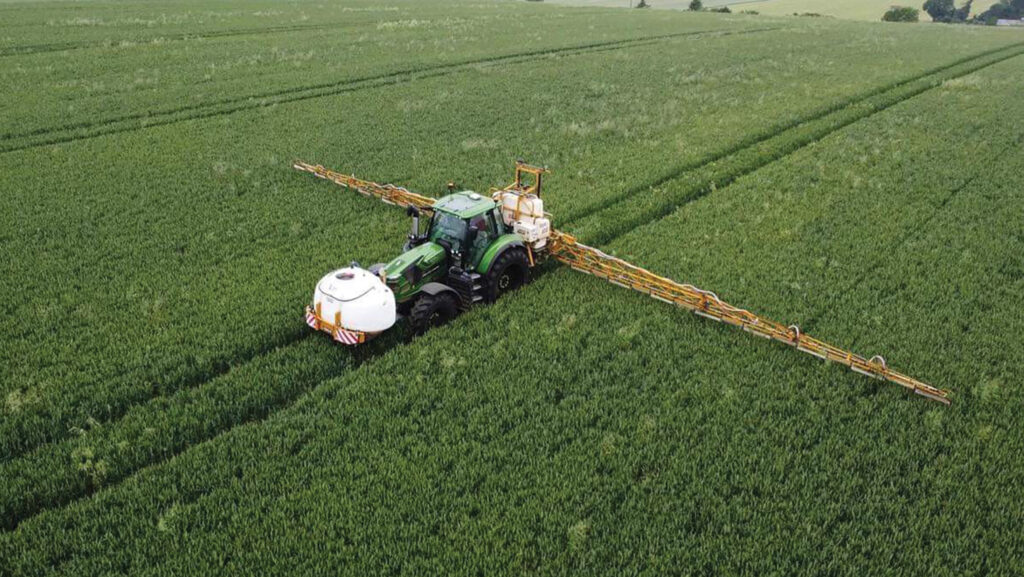Tackling wild oats: How to identify and map problem areas
 © Michael Shemilt
© Michael Shemilt It is more than 30 years since the first wild oats with resistance to fops and dims chemistry were identified in the UK, and since then, some feel the problem has got gradually worse.
Indeed, where herbicide resistance does occur, like other grassweeds, it can quickly cause serious problems, unless appropriate management measures are put in place, south Midlands-based Hutchinsons agronomist Michael Shemilt says.
See also: Advice on managing blackgrass with wetter, milder winters
“Wild oats are a very competitive grassweed that can get to unmanageable levels in a relatively short space of time if you’re not careful.
“Unlike blackgrass, seeds remain viable in the soil for many years, so there’s always a risk that problems can re-emerge in the future.”
Risks will be greater in rotations dominated by cereal cropping, where there is more reliance on a limited range of chemistry, he adds.
Adas resistance testing of nearly 600 wild oat samples over the past 13 years shows that where resistance does occur, it is most likely to be to fenoxaprop, followed by clodinafop, mesosulfuron + iodosulfuron, and pinoxaden.
Recent years have also found a few populations resistant to pyroxsulam, but so far there has been little resistance to cycloxydim, says Adas research consultant Dr Sarah Cook.
“Resistance to ALS herbicides is mainly enhanced metabolism resistance [EMR], with target site resistance to fops, dims and dens,” she notes.
Fortunately, resistance build-up in wild oats is relatively slow because oats are self-crossing and are hexaploid, so need multiple chromosomes to be affected to develop resistance.
Look beyond resistance
While herbicide resistance is a very real threat that must be identified and managed appropriately, Michael and other experts stress that it remains far less widespread than for other grassweeds, notably blackgrass or Italian ryegrass, and other factors may actually cause poor control in the field.
Indeed, some 68% of all wild oat samples tested by Adas were sensitive to herbicides.
And in another survey of about 100 samples by Niab, sponsored by Life Scientific, in summer 2020, the vast majority (85-90%) were susceptible to the key actives pinoxaden and iodosulfuron + mesosulfuron (see “Summary of findings from the Niab/Life Scientific wild oat survey”).
Furthermore, cross-resistance to two types of chemistry at the same time was found to be very rare, notes Life Scientific’s Ruth Stanley.
Given that the survey tested samples of wild oats from a collection of farms where people already suspected there might be a problem, the results were very encouraging from a resistance point of view, especially when compared with the issues facing other grassweeds, she says.

Ruth Stanley and John Cussans
Niab’s John Cussans agrees, adding that resistance to “den” chemistry, for example, affects about 10% of wild oat samples, yet in Italian ryegrass, the figure is nearer 50%, and blackgrass is more like 80%.
So what else is causing poor control? Experts say changes to cropping patterns, notably a shift towards cereal-based winter sowing, and changes in the chemistry used on-farm, could be playing a role, as could poor herbicide application or timing.
A key factor in recent years has been the move away from ALS-inhibiting chemistry (such as mesosulfuron + iodosulfuron) for blackgrass control, due to resistance concerns, says Ruth.
“Although the efficacy of such chemistry against blackgrass has declined, it was still doing a good job on wild oats, so as people stopped using it, more problems started to appear.”
The focus on blackgrass control, and a shift towards min-till systems, may also have contributed to more problems with wild oats, especially as the weeds need tackling in different ways, she adds.
What can be done about it?
The first step is to identify and map where problem areas are, which is usually easier to do during early summer when heads are visible above the crop canopy.
Next, growers should consider whether there are any obvious reasons why control has been less effective, rather than assuming it is down to herbicide resistance, says Michael.
Poor spray application or issues with timing are possible causes. For example, herbicides applied too late allow larger weeds to survive treatment, while spraying early risks missing later-emerging populations.
If herbicide resistance is suspected, then it is worth speaking to your agronomist to arrange a resistance test, as June/early July is an ideal time to collect samples once seed has matured (see “Tips for collecting seed samples”).

© Ruth Stanley
Resistance testing will not only tell you if herbicide resistance is present, and which actives are affected, but will also tell you which wild oat species are dominant.
Indeed, understanding the different oat species and their germination profiles is essential to target the most effective control measures.
There are two main wild oat species in the UK – common/spring wild oats (Avena fatua) is the most prevalent type in many areas, and winter wild oats (Avena sterilis subspecies ludoviciana), which although less common, are becoming more widespread.
The two species look similar, but are very different in several ways, notably their germination patterns, says John. Winter wild oats predominantly germinate in the autumn/winter, while common wild oats are mainly spring germinating.

Avena sterilis subspecies ludoviciana and Avena fatua seeds © Niab
In both cases though there will be a small proportion (typically about 30%) emerging outside of the main period.
Cropping patterns heavily influence the species found in the field, with autumn/winter cropping generally favouring more winter-germinating wild oats, and vice versa.
“Unlike blackgrass, changing the rotation to include more spring cropping, for example, simply shifts the balance of the population mix and does little to control wild oats.”
Four key control measures to consider are:
Hand roguing
Trials show that autumn-germinating wild oats typically produce 600-800 seeds a plant.
Although this is significantly less than blackgrass at almost twice that amount under the same conditions, it is still a significant number, so preventing seed return is key to reducing weed populations.
This is especially true given that the larger, more robust seeds of wild oats can survive in soil much longer, typically degrading by about 60% a year, compared with 70-80% for blackgrass, says John.
Wild oat plants can be very competitive too, with research suggesting that just one plant/sq m can reduce yields by as much as 1t/ha in winter cereals, and 0.6t/ha in spring cereals.
As harvest approaches, hand roguing is the only real option for reducing seed return at such a late stage in the season.
“Wild oats do shed their seed quite early, so don’t leave it too late,” says John.
Michael says wild oat problems generally begin as small patches within the field, so a few hours spent roguing can be time well spent and cut the risk of building up future problems.
On large areas, roguing may not be feasible, so other options need to be considered.
Cultivations
Wild oats have a complicated dormancy mechanism, so encouraging germination with stale seed-beds can have an effect, but is likely to be less effective than for weeds such as blackgrass, says John.
“It might encourage some older seed to germinate, but it’s unlikely to do much for seed that’s been freshly shed.”
Michael says some growers have found rolling stubbles can help stimulate germination.
Delaying cultivations for as long as possible after harvest can be a useful way of reducing population pressure, as freshly shed seeds are eaten by birds and other natural predators.
Others may germinate, or be lost to fungal attack. In contrast, incorporating fresh seed could induce dormancy.
Ploughing is an option as a “reset” where seed return has been particularly high, but it must be done well to completely bury seed, he adds.
Growers also need to recognise those seeds can survive dormant in the soil for many years, and should be wary of any old seed that ploughing might bring back up.
Cropping and seed rates
Depending on the main species present in the field, it may be possible to alter cropping choices to reduce wild oat numbers.
Where winter-germinating oats dominate, for example, a move to spring cropping allows a flush of weeds to be sprayed off before drilling the crop.
Cultural options are more limited where spring-germinating wild oats dominate, although John says increasing the seed rate of winter crops to establish a big, competitive crop canopy can help suppress those later germinating weeds.
Crop competition has less impact on winter wild oats, as they emerge around the same time as the crop, he adds.
Including non-cereal break crops in the rotation is a good way of tackling wild oats as it allows alternative forms of chemistry to be used, such as propyzamide in oilseed rape.
Herbicides
Understanding the type of oats and their resistance status is essential to target the most effective herbicide applications, says Ruth.
Testing shows cross-resistance – the ability to withstand herbicides from different chemical classes – is very rare, so even if one type of resistance is confirmed (such as to fops and dims), it is highly likely that other types of chemistry (such as ALS inhibitors) will still be effective.
Rotating or alternating herbicide mode of action is, therefore, an important part of the control strategy, but so too is accurate timing and correct spray application, regardless of the resistance status, she continues.
“ALS chemistry, for example, needs active weed growth to work properly. Cold, waterlogged soils, or other stress conditions, can inhibit growth and mean products won’t work effectively.”
Spray timings should also be tailored around species, so where there is a large proportion of winter germinating wild oats, there may need to be more focus on autumn pre-emergence residual control, such as tri-allate, which remains the most effective option.
This should be followed up with appropriate post-emergence chemistry in the spring to catch later emerging wild oats where necessary, says Michael.
Where the majority of the wild oat population is spring germinating, this may put more emphasis on post-em chemistry.
The key is to apply herbicides before wild oats get too large, usually around the one to three leaf stage of the weed, although he acknowledges this can be a real challenge in difficult seasons.
Once wild oats get bigger and start to tiller, control becomes more unreliable, Michael says.
Consideration should also be given to selecting the most appropriate nozzle type, water volume and forward speed to optimise spray coverage, he adds.
Where wild oats survive a programme of measures, a final option to prevent seed return – aside from hand roguing – is to use a weed wiper to apply a non-selective herbicide directly to oats protruding above the crop.
This can be effective in preventing some wild oats from fully maturing and shedding viable seed, but will not catch all weeds and requires careful timing and application, says Michael.
Summary of findings from the Niab/Life Scientific wild oat survey (summer 2020)
-
105 samples submitted – 97 tested
-
Tested for susceptibility to pinoxaden and iodosulfuron + mesosulfuron
-
About 30% of samples received contained winter wild oats, while 70% were spring wild oats
-
Farmers reported wild oat problems increased faster where winter wild oats were present
-
Testing found some cases of resistance in winter and spring wild oats to both actives
-
Cross-resistance to both herbicides was rare in both species (about 1% of samples)
-
Herbicide resistance appears to be higher in winter wild oats
Tips for collecting seed samples
For resistance testing to work and be as accurate as possible, a good seed sample is essential. Niab’s John Cussans outlines five key steps to do this:
- Timing of seed collection: Wait until seed is ripe and hard, just like any cereal seed. This typically occurs by July, depending on the season
- How to collect seed: Either run your hand along the head of the wild oat to gently dislodge seeds ready to be shed, or shake heads into a bucket. Do not strip the seed from heads or cut heads off as seed is unlikely to have fully matured
- Sample size: Because of the large seed size in comparison to other weeds, and likelihood of samples including some awns, husk, etc, ideally collect around three coffee mugs full of seed to send off for resistance testing
- Handling samples: Store seeds indoors in a paper bag or open container for a couple of days, then post in a paper bag
- Results: These generally take a few weeks to return and will confirm the presence and type of resistance, and the chemistry affected
Tips for managing wild oat resistance
- Identify and map potential problem areas where wild oat populations are visible
- Try to identify reasons for poor control, such as application or spray timing issues
- Collect seed samples and send for lab testing to confirm presence and type of resistance
- Prevent seed return wherever possible (such as with hand roguing, weed wiper)
- If hand roguing, remove whole plants to avoid regrowth
- Tailor cropping choices and soil management to the germination profile of wild oats present, for example:
- Winter-germinating oats – delayed drilling and spring cropping can allow effective stale seed-beds
- Spring-germinating oats – consider later spring drilling and targeted chemistry
- Delaying post-harvest cultivations allows more time for germination or predation of freshly shed seed
- Rolling seed-beds may help encourage germination
- Ploughing or other deep cultivations may bury wild oat seed, but beware of ploughing problems back up again in future
- Growing non-cereal crops (such as pulses, OSR) allows alternative chemistry to be used
- Apply herbicides early to target wild oats when small (one to three leaf stage) and more susceptible
- Tailor products according to the resistance profile in individual fields
- Use full rates
- Avoid tank mixing wild oat herbicides if possible to ensure optimum timing and application
- Continue to monitor herbicide performance and reasons for poor activity
Case study: Weed wiping and grass leys prove effective
A combination of cultural controls, plus weed wiping in early summer, is proving an effective way of managing herbicide-resistant wild oats for Bedford-based farmer Richard Cook.
Richard farms 566ha across three sites near Bedford and further south at Buckingham, focusing on producing quality milling wheats, alongside 1,950 EasyCare ewes.
Wild oats started becoming more problematic in the 1990s, when more ploughing was used following the straw burning ban.

Weed wiping on Richard Cook’s farm © Chris Lockwood
Richard believes this brought up dormant seed from depth, which was then unintentionally moved around fields by the combine and cultivations.
The introduction of Atlantis (iodosulfuron + mesosulfuron) did provide high levels of control at the time, but after a few years he noticed patches develop in fields that had survived treatment, but not due to poor application or spray misses. Herbicide resistance was confirmed by his agronomist at the time.
Integrated approach
Richard’s focus has since shifted away from a reliance on chemistry, towards a more integrated approach, incorporating different options with varying success.
“Most of our wild oat population germinates around the end of October into November, so while later drilling can help a bit, we’re not really able to wait long enough on our heavier Hanslope series clay to allow for a flush in the autumn, unless we leave drilling until March.”
Some good results have been achieved from growing maize and sugar beet, although these crops were dropped due to the impact on soils.
Of more benefit has been the inclusion of temporary (one- or two-year) grass leys in the arable rotation, which allow any wild oats growing within them to be either grazed or mown off before setting seed, thereby depleting the seed bank.
Weed wiping with glyphosate in early/mid-June has also been a valuable tool for the past 10-12 years. “There’s quite a narrow window for weed wiping to be effective,” Richard notes.
“We go in as soon as possible once oats are fully grown and in ear, but before they senesce, as wild oats need to be green for weed wiping to take out the whole plant rather than just the parts the sponge hits.”
Maintaining accurate boom height is key to effective weed wiping and minimising crop damage, and Richard says spring-loaded boom stabilisers help improve stability, while the tractor’s autosteer allows the sprayer operator to concentrate on maintaining boom accuracy.
“We’ve also found it’s better to go a bit faster, typically 15-16kph, as the oats make firmer contact with the sponge, improving the effectiveness of the herbicide.”
Double spring cropping
Working with Hutchinsons agronomist Michael Shemilt, Richard is also experimenting with back-to-back spring cropping (wheat and barley), which has proven very effective at reducing the autumn-germinating wild oat populations.
His favoured approach is to establish a cheap green cover of winter barley that lambs can graze over the winter, before spraying off and sowing a following cereal in the spring.
“There will still be oats in the spring cereal, but spring wheat in particular is very easy to weed wipe because it’s quite a short crop.
“It’s been a challenge, but we are slowly reducing the seed bank, mostly through weed wiping and rotational grass leys,” concludes Richard.
“In some areas where we’ve rotated grass more often, we’ve actually now reduced wild oat populations to a level where it is economic to hand rogue, so we’re getting there gradually.”
Wild oat numbers have been reduced by back-to-back spring cropping on the same field on Richard’s farm.
Year 1 (2016): Spring wheat – 100-150 plants/sq m
Year 2 (2017): Spring wheat – 30-60 plants/sq m
Year 3 (2018): First winter wheat – 3-12 plants/sq m

